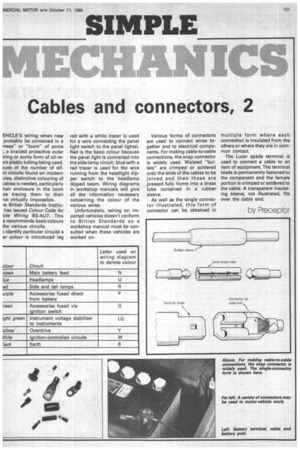Cables and connectors, 2
Page 123

If you've noticed an error in this article please click here to report it so we can fix it.
EHICLE'S wiring when new probably be contained in a mess" or "loom" of some I, a braided protective outer )ring or some form of oil-reint plastic tubing being used. use of the number of difnt circuits found on modern cies, distinctive colouring of 7,ables is needed, particularly heir enclosure in the loom :es tracing them to their rce virtually impossible.
le British Standards lnstituhas issued Colour Code for icle Wiring BS-AU7. This e recommends basic colours the various circuits.
J identify particular circuits a er colour is introduced (eg red with a white tracer is used for a wire connecting the panel light switch to the panel lights). Red is the basic colour because the panel light is connected into the side-lamp circuit; blue with a red tracer is used for the wire running from the headlight dipper switch to the headlamp dipped beam. Wiring diagrams in workshop manuals will give all the information necessary concerning the colour of the various wires.
Unfortunately, wiring on imported vehicles doesn't conform to British Standards so a workshop manual must be consulted when these vehicles are worked on. Various forms of connectors are used to connect wires together and to electrical components. For making cable-to-cable connections, the snap connector is widely used. Waisted "bullets" are crimped or soldered onto the ends of the cables to be joined and then these are pressed fully home into a brass tube contained in a rubber sleeve.
As well as the single connector illustrated, this form of connector can be obtained in multiple form where each connection is insulated from the others or where they are in common contact.
The Lucar spade terminal is used to connect a cable to an item of equipment. The terminal blade is permanently fastened to the component and the female portion is crimped or soldered to the cable. A transparent insulating sleeve, not illustrated, fits over the cable end.












































































































































































